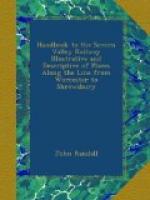Our view of the Valley of the Severn, with Ironbridge in the distance, is from the hill overlooking the handsome mansion of John Anstice, Esq.
[Ironbridge: 27.jpg]
Coalport is in the parish of Madeley, the village of which is now looped in by railways. Madeley is one of those names or word-pictures by which our ancestors, with a touch alike of poetry and feeling, were wont to convey their meaning. The place, however, has lost those sylvan features that distinguished it when described in Domesday, as part of the possessions of St. Milburgh; and the old Court House, surrounded by its park, where the prior of that monastery received his perquisites, is strangely changed in aspect. Although little beyond the foundations exist to show where the hall stood from whence the house derives its name—where festivals were held, suitors heard, or penalties inflicted—the present edifice has many points of interest. The arms of the Ferrers family, in a shield, over the principal doorway, may still be seen, indicating the proprietorship at one time of some member of that family. It was also the residence of Sir Basil Brooke, fourth in descent from a noble knight of that name; a zealous royalist in the time of Charles I. The substantial, roomy, and well-panelled apartments, and the solid trees, one upon the other, forming a spiral staircase, are objects of interest. Ascending these stairs, the visitor finds himself in the chapel, the ceiling of which is of fine oak, richly carved, with the fleur-de-lis and other devices. In the garden, which formed an enclosed court, upon an elegant basement approached by a circular flight of steps—the outer one being seven feet in diameter and the inner one about three—is a very curious planetarium, or horological instrument, serving the purpose of a sun dial, and that of finding the position of the moon in relation to the planets. In niches outside the parish church are finely sculptured, full-length figures of some of the early proprietors of the Court House; and in the register is an entry dated April, 1645, stating that the edifice was at that time garrisoned by a Parliamentary regiment, commanded by Captain Harrington. Six years later than the event recorded, we have the story of King Charles’ visit to the village in disguise, after the battle of Worcester, and of his being lodged in a barn belonging to Mr. Wolfe. At the Restoration the king did not forget his host, but presented him with a very handsome tankard, with the inscription, “Given by Charles II., at the Restoration, to F. Wolfe, of Madeley, in whose barns he was secreted after the defeat at Worcester.” The tankard is now in the possession of W. Rathbone, Esq., and a print of it hangs in the old house, now the possession of C. J. Ferriday, Esq. The tankard has upon the cover a coat of arms; the crest is a demi-wolf supporting a crown. In the hall there is also an old panel, containing the initials F. W. W. Mr. and Mrs. Wolfe, with the date 1621.




